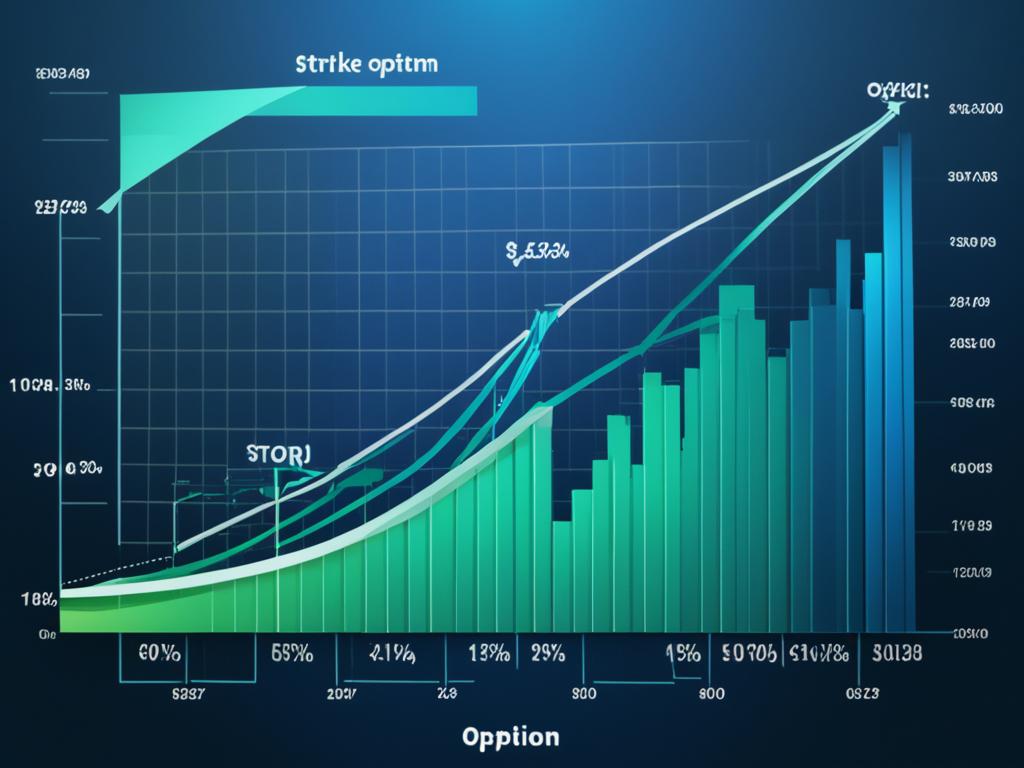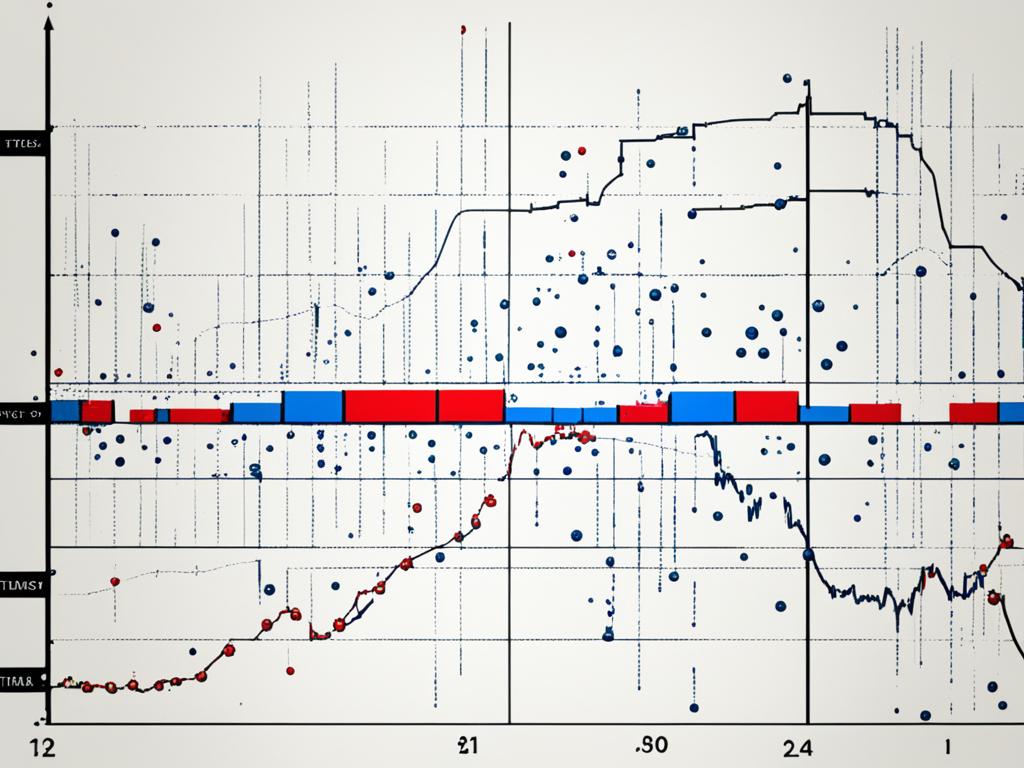
The Basics of Options Trading
Options trading is a key strategy for smart investors today. It involves financial contracts that let the holder buy or sell an asset at a set price later. Learning about options trading is crucial for those who want to grow their portfolios, manage risks, and earn more.
This part will cover the main ideas of options trading. It will help you understand call and put options, strike prices, and expiration dates. Knowing these basics lets investors make better choices and reach their goals.

We’ll dive into the details of options trading and how they work. This is useful for both experienced traders and beginners. By the end, you’ll know how to use options to make the most of market trends.
Understanding Options Contracts
Options contracts are a key tool for traders. They offer the right to buy or sell an asset at a set price and time. These contracts come in two main types: call options and put options.
Call and Put Options
A call option lets the holder buy the asset at a set strike price before the expiration date. On the other hand, a put option lets the holder sell the asset at the strike price before the contract ends.
Choosing between call and put options depends on the trader’s market view and strategy. Traders buy call options when they think the asset’s price will go up. They buy put options when they think the price will drop.
Options Trading: Strike Prices and Expiration Dates
The strike price is the set price for buying or selling the asset with the options contract. It, along with the expiration date, affects the contract’s value and risk.
Expiration dates mark the last day to use the options contract. These dates can be a few days or several years away, based on the contract. Being close to the expiration date can change the options’ prices and how traders decide.
| Option Type | Description | Profit Potential | Risk Profile |
|---|---|---|---|
| Call Option | Right to buy the underlying asset | Unlimited | Limited to the premium paid |
| Put Option | Right to sell the underlying asset | Limited to the strike price minus the asset’s price | Limited to the premium paid |
Knowing about call options, put options, strike prices, and expiration dates is key for trading in the options market. It helps traders make smart choices.

Options Trading: Option Pricing Fundamentals
Learning the basics of options pricing is key for traders in the complex world of derivatives trading. Two main factors affect an options contract’s value: volatility and time value.
Volatility measures how much an asset’s price changes. Higher volatility means higher options prices because there’s a bigger chance the option will end up in the money. On the other hand, lower volatility leads to lower prices because the asset’s price change is less likely.
Time value is the part of an option’s price due to the time left until it expires. As expiration nears, time value goes down, making the option less valuable. This time decay is important for traders to know, as it affects their profits.
Another key factor is intrinsic value. It’s the difference between the asset’s current price and the option’s strike price. A higher intrinsic value means the option is more likely to be exercised, making it more valuable.
| Factor | Impact on Options Pricing |
|---|---|
| Volatility | Higher volatility leads to higher options prices, as the likelihood of the option finishing in-the-money increases. |
| Time Value | As an option approaches expiration, its time value decays, causing the option’s overall value to decrease. |
| Intrinsic Value | The higher the intrinsic value, the more valuable the option becomes, as it is more likely to be exercised at expiration. |
Understanding these basics of options pricing helps traders make better choices in the options market. It’s key for creating strong trading strategies.

Trading Options
Options trading gives traders many tools to handle different market situations. From option strategies like covered calls to option spreads, there are many ways to make money and manage risks.
Option Strategies
A common strategy is the covered call. Here, a trader owns the asset and sells a call option on it. This can bring in money from the option premium and let the trader benefit from price increases. Another strategy, option spreads, involves buying and selling options at the same time. This is done to profit from changes in volatility or strike prices.
Options Greeks and Risk Management
Understanding the options Greeks is key to managing risks in options trading. These include delta, gamma, and vega, which show how an option’s value changes with the asset’s price, volatility, and time left to expire. By watching these options Greeks, traders can make better decisions and use strong risk management strategies.
| Option Strategy | Description | Potential Benefit |
|---|---|---|
| Covered Calls | Selling call options on an asset you own | Generate income from option premiums |
| Option Spreads | Buying and selling options simultaneously | Exploit changes in implied volatility or strike prices |

By learning and using different option strategies and keeping an eye on the options Greeks, traders can improve their risk management. This can open up new chances in the options market.
Volatility Trading
In the world of options trading, volatility is key. It measures how much an asset’s price changes. Knowing about volatility helps traders find great opportunities in the market.
Options Trading: Implied Volatility and Strategies
Implied volatility looks ahead at what an asset’s price might do. By comparing it to past volatility, traders can spot good deals. They use strategies like volatility arbitrage, straddles, and iron condors to make the most of these chances.
Trading volatility means watching the market closely and using the right strategies. This can help traders do well in the complex options market. By using volatility to their advantage, traders can find new ways to make money.
FAQ
What is the difference between a call option and a put option?
A call option lets the holder buy the asset at a set price. A put option lets the holder sell the asset at that price.
How do strike prices and expiration dates affect options contracts?
The strike price is the deal price for exercising the option. The expiration date is when the option must be used. These details change the value and risk of an options contract.
What is the role of volatility in options pricing?
Volatility, both past and expected, affects options prices. More volatility means higher option prices. This is because it suggests big price changes in the asset.
What are some common options trading strategies?
Popular strategies include covered calls, bull call spreads, bear put spreads, and iron condors. These help make money, manage risk, or take advantage of market conditions.
How do the options Greeks (delta, gamma, theta, vega) help in risk management?
The options Greeks help manage risks in options trades. Delta shows how an option’s price changes with the asset’s price. Vega shows how it changes with volatility.
How can traders use implied volatility in their trading strategies?
Traders can spot underpriced or overpriced options by looking at implied volatility. This helps in making strategies like selling options when volatility is high or buying when it’s low.



Nice information about trading, it’s really helpful.
I appreciate the explanation of options terminology. It’s overwhelming at first, but this post helped break it down in a digestible way